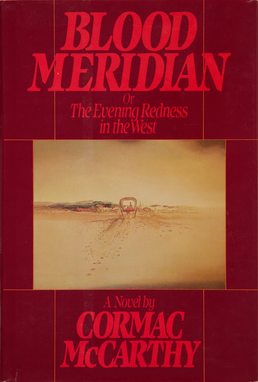Part 16
byPart 16 of Blood Meridian unfolds in a stark and unforgiving landscape, where the narrative follows a group of riders making their way across a bleak, snow-covered expanse in the early morning hours. The landscape around them is quiet, with the only signs of life being the constellations like Cancer and Cassiopeia gleaming high in the sky. As they ride through this desolate terrain, they come across abandoned farmlands, where only the skeletal remains of dried fruits serve as reminders of past life. This emptiness underscores the harsh reality of their journey, as they push forward through a world that has been stripped of its vibrancy, leaving only the remnants of what once was. The group rides deeper into the land, passing through a valley that eventually leads them to meadows filled with deer and the faint lowing of cattle in the distance, adding a slight touch of life to an otherwise barren world.
The following day, their journey brings them to the ruins of San Bernardino, where the remnants of a once-thriving community are now overrun by wild bulls. These bulls, with their Spanish brands still visible, symbolize the forgotten past and the wildness that has taken over the land. A tense moment arises when one of the bulls charges at James Miller, forcing him to shoot the animal to protect himself and his struggling horse. This violent encounter serves as a reminder of the unpredictable dangers they face as they continue their journey through a land that offers no respite. As the group rides further along the Santa Cruz River, they encounter the impressive cottonwoods lining the riverbanks but find no signs of the missing scouts they were hoping to locate. Despite their efforts, the lack of any Apache signs or traces of the scouts only heightens their sense of unease, deepening the sense of uncertainty that hangs over their journey.
As they proceed, they make their way to the mission at San Jose de Tumacacori, where the enigmatic judge begins to share his knowledge of the site’s history. His insights are dubious, as it becomes apparent that he has never visited the mission before, which casts doubt on his credibility. While exploring the ruins of the church, the group encounters a dying man, his homemade clothes suggesting he has been living off the land for some time. In his final moments, he points toward an unknown direction, hinting at something beyond his own understanding or grasp, deepening the mystery of the situation. The narrative takes a further turn when they meet another hermit, who turns out to be the dead man’s brother. His indifference to his sibling’s death highlights the apathy and isolation that permeate the harsh realities of their existence. The interaction reveals the cold, unfeeling nature of life in this unforgiving world, where even family bonds seem to hold little meaning in the face of survival.
The group continues its journey, passing through deserted territories and abandoned settlements that serve as stark reminders of the world’s decay. In Tubac, they encounter a blind man, his presence adding to the eerie desolation that surrounds them. As they set up camp in the vast, empty desert, they remain on high alert for Apache threats, knowing that danger could strike at any moment. Eventually, they follow a trail that leads them to a horrifying discovery: the bodies of the lost scouts, hanging from a tree, mutilated and left as a grim warning. This shocking revelation serves as a chilling reminder of the violence and brutality that has come to define their existence. It also highlights the ruthless nature of the world they inhabit, where survival often comes at the expense of others, and the line between predator and prey is razor-thin.
As the group draws closer to Tucson, the underlying tension among the men grows. Their interactions with Apache riders reveal the deep cultural differences and misunderstandings that have fueled conflict for years. This encounter sets the stage for a larger confrontation, with the tension building between the group of riders and the Apache forces. The cultural rifts, combined with the ever-present threat of violence, suggest that an inevitable clash is looming, one that will test the characters’ survival instincts and challenge their beliefs about morality, loyalty, and justice. This chapter intensifies the sense of dread and foreboding that permeates the story, highlighting the fragility of peace in a world where violence and conflict are constant companions.

